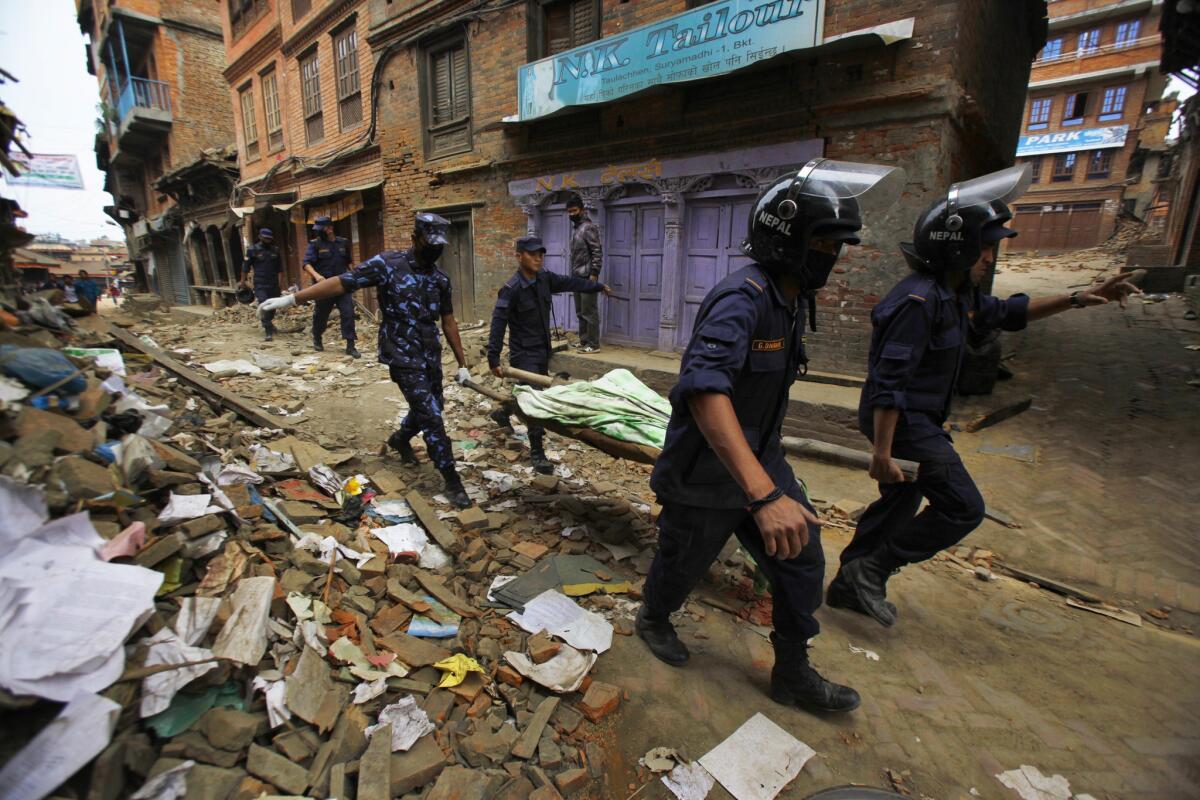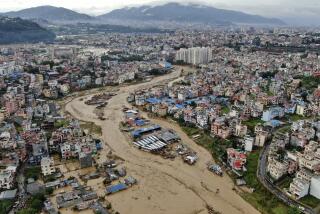6.7 aftershock hits Nepal; quake death toll tops 2,200

Nepalese rescue workers carry a body recovered from a collapsed building in Bhaktapur, near Katmandu.
- Share via
reporting from KATMANDU, Nepal — A powerful aftershock shook Nepal on Sunday, making buildings sway and sending panicked Katmandu residents running into the streets a day after a massive earthquake left more than 2,200 people dead.
The cawing of crows mixed with terrified screams as the magnitude 6.7 aftershock pummeled the capital city early Sunday afternoon. It came as planeloads of supplies, doctors and relief workers from neighboring countries began arriving in this poor Himalayan nation.
“The aftershocks keep coming … so people don’t know what to expect,” said Sanjay Karki, Nepal country head for global aid agency Mercy Corps. “All the open spaces in Katmandu are packed with people who are camping outdoors. When the aftershocks come you cannot imagine the fear. You can hear women and children crying.”
Saturday’s magnitude 7.8 earthquake spread horror from Katmandu to small villages and to the slopes of Mount Everest, triggering an avalanche that buried part of the base camp packed with foreign climbers preparing to make their summit attempts. At least 17 people died there and 61 were injured.
The earthquake centered outside Katmandu, the capital, was the worst to hit the South Asian nation in over 80 years. It destroyed swaths of the oldest neighborhoods of Katmandu, and was strong enough to be felt all across parts of India, Bangladesh, China’s region of Tibet and Pakistan. By Sunday afternoon, authorities said at least 2,169 people had died in Nepal alone, with 61 more deaths in India and a few in other neighboring countries. At least 721 of them died in Katmandu alone, and the number of injured nationwide was upward of 5,000. With search and rescue efforts far from over, it was unclear how much the death toll would rise.
But outside of the oldest neighborhoods, many in Katmandu were surprised by how few modern structures — the city is largely a collection of small, poorly constructed brick apartment buildings — collapsed in the quake. While aid workers cautioned that many buildings could have sustained serious structural damage, it was also clear that the death toll would have been far higher had more buildings caved in.
On a flight into Katmandu on Sunday morning, an AP correspondent was unable to spot any collapsed buildings.
Aid workers also warned that the situation could be far worse near the epicenter. The U.S. Geological Survey said the quake was centered near Lamjung, about 80 kilometers (50 miles) northwest of Katmandu, in the Gorkha district.
Roads to that area were blocked by landslides, hindering rescue teams, said chief district official Prakash Subedi. Teams were trekking through mountain trails to reach remote villages, and helicopters would also be deployed, he said by telephone.
The aid group World Vision said in a statement that remote mountain communities, including in Gorkha, were totally unprepared for the level of destruction caused by the earthquake.
Villages near the epicenter “are literally perched on the sides of large mountain faces and are made from simple stone and rock construction. Many of these villages are only accessible by 4WD and then foot, with some villages hours and even entire days’ walks away from main roads at the best of times,” the group’s local staff member, Matt Darvas, said in the statement.
He said he was hearing that many of the villages may have been completely buried by rock falls.
“It will likely be helicopter access only for these remote villages,” he said.
Nepal’s worst recorded earthquake in 1934 measured 8.0 and all but destroyed the cities of Katmandu, Bhaktapur and Patan.
With people fearing more quakes, tens of thousands of Nepalese spent Saturday night outside under chilly skies, or in cars and public buses. They were jolted awake by strong aftershocks early Sunday.
“There were at least three big quakes at night and early morning. How can we feel safe? This is never-ending and everyone is scared and worried,” said Katmandu resident Sundar Sah. “I hardly got much sleep. I was waking up every few hours and glad that I was alive.”
As day broke, rescuers aided by international teams set out to dig through rubble of buildings — concrete slabs, bricks, iron beams, wood — to look for survivors.
In the Kalanki neighborhood of Katmandu, police rescuers finally extricated a man lying under a dead person, both of them buried beneath a pile of concrete slabs and iron beams. Before his rescue, his family members stood nearby, crying and praying. Police said the man’s legs and hips were totally crushed.
Hundreds of people in Kalanki gathered around the collapsed Lumbini Guest House, once a three-story budget hotel and restaurant frequented by Nepalese. They watched with fear and anticipation as a single backhoe dug into the rubble.
Police officer RP Dhamala, who was coordinating the rescue efforts, said they had already pulled out 12 people alive and six dead. He said rescuers were still searching for about 20 people believed to be trapped, but had heard no cries, taps or noises for a while.
Most areas were without power and water. The United Nations said hospitals in the Katmandu Valley were overcrowded, and running out of emergency supplies and space to store corpses. Plumes of smoke, meanwhile, rose above the capital as friends, relatives and others gathered by the river to quickly cremate loved ones’ remains.
Most shops in Katmandu were shut; only fruit vendors and pharmacies seemed to be doing business. Karki, of Mercy Corps, said there were long lines outside pharmacies because people fear they will run out of medicine.
Fruit seller Shyam Jaiswal vowed not to raise prices, though stocks were fast running out.
“This is all we will have for a while. We don’t expect any more shipments for at least a week. More people are coming now. They cannot cook so they need to buy something they can eat raw. We try to help everyone. But we are not raising prices. That would be illegal, immoral profit. That would be wrong,” Jaiswal said.
The quake will likely put a huge strain on the resources of this impoverished country best known for Everest, the highest mountain in the world. The economy of Nepal, a nation of 27.8 million people, relies heavily on tourism, principally trekking and Himalayan mountain climbing.
With Katmandu airport reopened, the first aid flights began delivering aid supplies. The first to respond were Nepal’s neighbors — India, China and Pakistan, all of which have been jockeying for influence over the landlocked nation. Still, Nepal remains closest to India with which it shares deep political, cultural and religious ties.
Indian air force planes landed Sunday with 43 tons of relief material, including tents and food, and nearly 200 rescuers, India’s External Affairs Ministry spokesman Vikas Swarup said. The planes were returning to New Delhi with Indian nationals stranded in Katmandu. More aid flights were planned for Sunday.
India suffered its own losses from the quake, with at least 61 people killed there and dozens injured. Sunday’s aftershock was also widely felt in the country, and local news reports said metro trains in New Delhi and Kolkata were briefly shut down when the shaking started.
A 62-member Chinese search and rescue team also arrived Sunday. Other countries sending support Sunday included the United Arab Emirates, Germany and France.
Pakistan prepared to send four C-130 aircraft, carrying a 30-bed temporary hospital comprising army doctors, surgeons and specialists. An urban search and rescue team was also sent with ground-penetrating radars, concrete cutters and sniffing dogs. Pakistan was also sending 2,000 ready-to-eat meal packs, water bottles, medicines, 200 tents, 600 blankets and other necessary items.
When the earth first shook, residents fled homes and buildings in panic as walls tumbled, trees swayed, power lines came crashing down and large cracks opened up on streets. After the chaos of Saturday — when little organized rescue and relief was seen — there was more order on Sunday as rescue teams fanned out across the city.
Workers were sending out tents and relief goods in trucks and helicopters, said disaster management official Rameshwar Dangal. He said government and private schools have been turned into shelters.
Mukesh Kafle, the head of the Nepal Electricity Authority, said power has been restored fully to main government offices, the airport and hospitals.
Among the destroyed buildings in Katmandu was the nine-story Dharahara Tower, a Katmandu landmark built by Nepal’s royal rulers as a watchtower in the 1800s and a UNESCO-recognized historical monument. It was reduced to rubble and there were reports of people trapped underneath.
The Katmandu Valley is listed as a World Heritage site. The Buddhist stupas, public squares and Hindu temples are some of the most well-known sites in Katmandu, and now some of the most deeply mourned.
The head of the U.N. cultural agency, Irina Bokova, said in a statement that UNESCO was ready to help Nepal rebuild from “extensive damage, including to historic monuments and buildings of the Katmandu Valley.”
Nepali journalist and author Shiwani Neupane tweeted: “The sadness is sinking in. We have lost our temples, our history, the places we grew up.”
More to Read
Sign up for Essential California
The most important California stories and recommendations in your inbox every morning.
You may occasionally receive promotional content from the Los Angeles Times.










